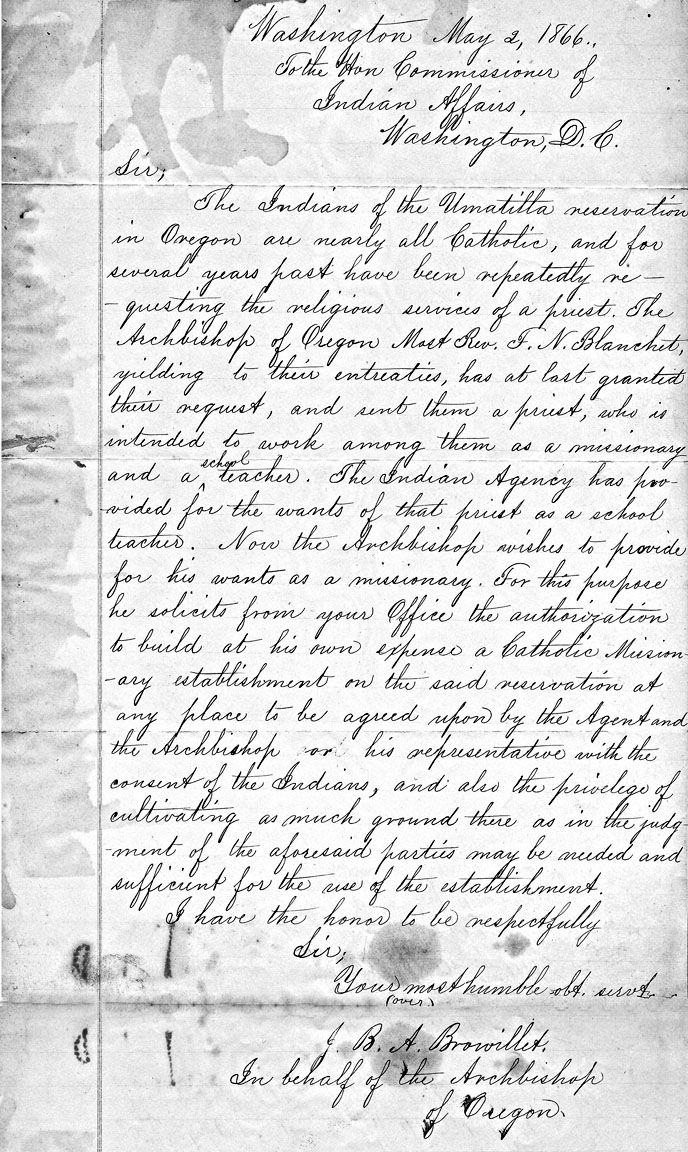- Catalog No. —
- Mss 1500
- Date —
- May 2, 1866
- Era —
- 1846-1880 (Treaties, Civil War, and Immigration)
- Themes —
- Environment and Natural Resources, Government, Law, and Politics, Native Americans, Oregon Trail and Resettlement, Religion
- Credits —
- Oregon Historical Society
- Regions —
- Northeast
- Author —
- Jean Baptiste A. Brouillet
From Jean Baptiste A. Brouillet
Catholic priest Jean Baptiste A. Brouillet wrote this letter to the United States Commissioner of Indian Affairs on May 2, 1866. In it, Brouillet requested permission to construct a Catholic Mission on the Umatilla Indian Reservation in eastern Oregon.
Although Roman Catholic missionaries occasionally visited the Plateau region of eastern Oregon and Washington in the 1840s, they did not begin a concerted effort to evangelize the local Native groups until November 1847. In collaboration with the Cayuse leader Taawitoy, Brouillet established St. Ann’s mission in Cayuse territory at a site along the Umatilla River. Following the killings at the nearby Presbyterian mission at Waiilatpu that November—commonly known as the Whitman Massacre—and the subsequent hostilities between the Cayuse and a volunteer settler militia, Brouillet attempted to maintain a neutral position. However, he was forced to abandon the mission in February 1848. Missionaries returned for brief periods in 1849 and again in the early 1850s, but Catholic officials did not undertake renewed missionary efforts until the 1860s.
After being forcibly resettled onto the Umatilla Indian Reservation in the late 1850s, some members of the Cayuse, Umatilla, and Walla Walla groups expressed a desire for Catholic religious and educational services. Interest was particularly strong among the Walla Walla. They had previously intermarried with French Canadian Catholics stationed at Fort Nez Perces, the fur trade post located in Walla Walla territory. Missionaries reestablished St. Ann’s mission on the reservation in the mid-1860s. As part of President Ulysses S. Grant’s 1870 Peace Policy, which encouraged religious groups to work with Native Americans, Catholic missionaries received government aid to promote Christianity and assimilation policies on the reservation. A variety of both male and female Catholic missionaries staffed the church and school at the mission through the early twentieth century. In the early 1890s, the name of the mission was changed to St. Andrews, the name it retains to this day. In addition to St. Andrew’s Mission, the Umatilla Indian reservation is also currently home to a Presbyterian Church and a Seventh Day Adventist School and Church.
Further Reading:
Stern, Theodore. “Cayuse, Umatilla, and Walla.” In Handbook of North American Indians. Vol. 12. Plateau. Edited by. Deward E. Walker. Washington D.C., 1998.
Peterson, Jacqueline and Laura Peers. Sacred Encounters: Father De Smet and the Indians of the Rocky Mountains. Norman, Okla., 1993.
Written by Melinda Jette, © Oregon Historical Society, 2003.
